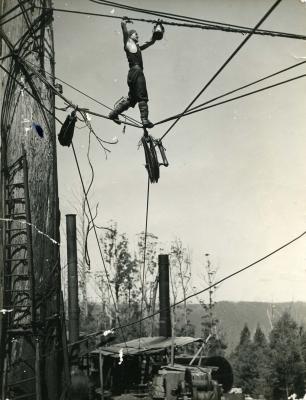Born in Warburton on 28 January 1920, Des Morrish was an old-time timberman – a breed of tough bushmen who lived out in the rough bush settlements such as Federal Mill. Des spent his entire working life in the timber industry, and even when interviewed by myself in his 94th year in 2012, Des loved nothing more than explaining the techniques of the high lead logging system, and reminiscing about the old days of climbing the mighty Mountain Ash, high up in the mountain ranges above Warburton.
THE TIMBER INDUSTRY
I was born and bred in Warburton, and at the age of 16 I first went out into the timber industry. I got a job as a sawdust boy, wheeling sawdust, at a little sawmill on Crooked Creek called the White Slaves mill, where I was paid £2/0/6 per week. This mill was eight miles out from Warburton towards McMahon’s Creek, and I used to ride my bike there and back every day.
This was the only job a 16 year old was allowed to do – they wouldn’t let you anywhere near the saws at that age, but then when I turned 17 I progressed through the mill, doing different jobs, such as working on the ‘little bench’, where we cut broom handles, pickets and so on.
“One time we logged a patch of Silvertop poles, and they had a terribly rough bark on them, like pine bark. My job was to take the bark off with a crow bar and chop the ends off to make them square. Alec Isaacs was the benchman and Bill Partridge was pulling off, and as I could pull the bark off, they cut them up on the saw bench. It was a stinking hot day, and the sweat was pouring out of me. Then the boss, Bill Downey, walked past and said to me, ‘Just as well you’ve got a good easy job today Des!’
The sawmill had a little tramway which ran 1½ miles down to the main road, where the timber went into Warby by lorry. There were two bridges along this tramway, where most of the bush had been cut out, but there were still a few trees we were cutting just before Christmas 1938. We had a few fires going in the clearing, just burning the heads off these trees, and one of these fires got away and burnt the two tramway bridges out.
My mate was Jack Cameron, who was one of the best workers I ever met. He and I were given the job of replacing the bridges just after Christmas, and so we went out on the 6th and 7th of January, and we cut up some timber and rebuilt the bridges, but we couldn’t do any more until the mill started up to cut the wooden rails for them.
BLACK FRIDAY BUSHFIRES
We usually got about a 60 or 70 inch annual rainfall in Warburton, but in 1938 there was a terrible drought, when we only had about 16 inches for the year. Then on Friday 13 January 1939, six days after we’d done the bridge job, the Black Friday bushfires came through and burned the bridges out as if they had never been there. All the fish in Crooked Creek were dead and were belly-up, although we weren’t sure whether it was the heat that killed them, or whether they were killed by the charcoal contaminating the water.
I was in the Warburton fire brigade at the time, and Max Sparkes was the Captain. I lived next door to Max, and on Thursday the 12th I said to him, ‘I’m not going into work tomorrow, there’s a bad day coming up.’ On the morning of the 13th, Harry Martyr, Max and I were on the Dodge fire truck. It was our only truck and it didn’t carry water, so we could only pump water from a river or dam. We went up to the aqueduct which used to run between the O’Shanassey and Silvan Reservoirs, although what we thought we were going to do there I don’t know. It was extremely hot, so Harry and I went for a swim in the channel.
Then the fire came down from the north west, from the direction of Mount Donna Buang and Mount Ben Cairn. The noise was incredible – it sounded just like a thousand tornadoes, and then the wind changed and it took the fire down through Parbury’s Creek, where the golf course is now. It sizzled down the hill and crossed the Yarra River, then raced up the other side of the valley, and within seconds Mount Little Joe and all the southern side of Warburton was ablaze. So we went back down into the town, and the truck was wanted everywhere at once – Big Pat’s Creek, East Warburton, McMahons Creek – as there were fires everywhere.
But Max said, “This fire truck is here to protect the township of Warburton, and it remains in town. If we take it out in the bush it will get burnt, and we’ll get burnt, and we’ll lose the town as well.“
All the shops were built next to one another, and many of them were built ten or twelve feet off the ground, so they could easily have gone up and the whole town could have burnt down. We were there to put the spot fires out, and we spent all day driving around the outskirts of town, putting out these spot fires as best we could. There wasn’t much panic in town, and the townsfolk were very good. The shopkeepers brought out with crates of drinks and sandwiches and everybody pulled together well.
It rained on the Sunday, so we thought we’d go out to check things out at Matlock. But when we got to the McVeigh’s pub and drove past the ‘goose neck’, a big sharp bend in the road, the most incredible scene confronted us. There were all these big, full sized trees just ripped completely out of the ground and strewn all over the place, all with great clumps of dirt still attached to their roots. They had been literally sucked out of the ground by the wind, and it was as if a giant had come along and strewn a box of matches everywhere. You could have walked for miles on tree trunks without touching the ground. This was thought to have been caused by the updraft of the wind as it rose up to get more oxygen, which was estimated at well over 200 mph! So of course we couldn’t get through, and we went back to Warby.
We found out later it had been carnage up at Matlock. At Jimmy Fitzpatrick’s sawmill, 15 men and 12 horses lost their lives in the fire. Only one man survived, George Sellars. He’d found a bare patch of ground and he got blankets off his bed and two 4 gallon drums of water, and he kept tipping water over his blankets, and that was how he remained alive.
On the other side of the road, Victor Yelland’s old sawmill had been bought by a bloke named Henderson, and he’d built a little brick house. When the fire came, big Ted Silver had 11 men and one lady – the cook – inside this brick house. The lady panicked and rushed out into the flames, and her body was never found. The men said they couldn’t bare the heat any longer, and they should pray to the Lord for help.
Ted said “I’ve never prayed to the Lord in all my life, and I’m not going to be a hypocrite and ask for help now.“
Then he said, “If you listen to me, I think I can save your lives. We’re going to stop in this house as long as we possibly can. Drop to the floor and fill your lungs – the best air you’re going to get is from near the floor. Once the big fire’s gone, we’ll get out and run down to the water supply, where it will be green and we can find some water. If the heat gets too much, drop to the ground and dig through the ashes and dirt and put your mouth in there and get some air into your lungs.“
The men did as he said, and they all survived.
The fire truck from Woods Point came up to Matlock, and when the blokes got there they found most of the charred bodies lying up near the sawdust heap. Jimmy Fitzpatrick’s two boys were found dead inside the mill’s water tank, where they’d either boiled or suffocated. They got some coffins and put the bodies inside, then loaded them onto a tray-bodied truck and took them to Mansfield.
Woods Point had a bad time of it, too. Doug Ross had the bakery, and on the day of the fire he’d put a batch of bread in the oven, but hadn’t yet fired it. The heat of the fire was so intense that it baked the bread, and this was all the townsfolk had in the end. The amazing thing was that the whole of the goldfields from Walhalla through Aberfeldie to Woods Point had been denuded of most of the trees over the years, as firewood was in such high demand. It had become almost a man-made desert. And yet despite this, the fire still came through and ravaged the place, such was its intensity. And they talk today about containment lines!
Ted Silver, the man who saved so many in the Matlock fires, was a big, tall, long-armed bugger. In 1940 he went to war, and was awarded a medal for bravery. He lived in Don Valley, near the Launching Place Hotel, and he used to get in there and get too much beer in him and make a nuisance of himself. One day in 1953 he was causing trouble, and a man named Barton stood up and objected. Big Ted gave him a hell of a hiding, but some time later this fellow came back looking for Silver, and he shot him dead, along with another man.
In 2009, we had a five day remembrance at the old Church of England in Warburton for the 70th anniversary of the Black Friday bushfires. There were a few of the old timers in the place, and each of us gave spoke of our memories from the fires. Old Norm Golding, then 101 years of age, spoke about what he did that day. Norm ran a bus service between Powelltown and Lilydale, and on Black Friday he was on the road beyond Powelltown, when he came across three little girls. The fire was coming, so he grabbed them and put them in the railway tunnel to keep them safe from the fires. When Norm had finished saying this, a lady in the congregation stood up and said, “I was one of those little girls that you picked up and put in the tunnel.“ Norm looked at her and said, “Lady, you were well worth saving!“ Her name was Leslie Forrest, (nee Bramich), and it turned out that I used to play tennis with her mum and dad, so the whole thing was very touching.
TANJIL BREN
All the timber was cut out already – the fire just finished it off – so Bill moved the operations to his new sawmill at Tanjil Bren. On the Sunday afternoon, we all piled into Bill’s car for the long drive up to the mill, which was an eight mile walk into the bush from the road. War was declared on 3 September 1939, on a Sunday night, and as we had no communications at the sawmill, it was a full week before we arrived back at Warburton and found out about it.
FEDERAL TIMBER PRODUCTS
In 1940 I took a job with FTP, Federal Timber Products, who owned Federal Mill. I worked there all through the 1940s until the mill closed in 1950. The mill was connected to La La siding at Warburton by a 20 mile-long tram line, a distance later reduced to 17 miles once the company put a few shortcuts in. We had a drum saw which we used to cut barrel staves, and these went on the tram, which was driven either by Watti Clinch and George Bullen. At La La the timber was loaded onto Victorian Railways trains and railed off to Yarraville where it was made into barrels.
I lived at Warby, as did most of the mill workers, and I used to walk the 17 miles to and from the mill each week, which took me about five hours. Work started at half past seven in the morning, and we worked eight hour days, plus Saturday mornings. And all this for just £3 per week! At Federal, you could please yourself whether you batched in one of the huts or stayed at the boarding house. I preferred to batch. When I knocked off work in the afternoon, I was often so buggered that I’d have a wash, cook myself some tea, and I’d be ready for bed.
We had to work until quarter to one on Saturdays, which was no good if you wanted to play football on the Saturday afternoon. The mill engine driver, Barry Milkins, was a real character. He was a returned man from the WWI, and was a very learned, well-cultured man, and he was our boxing instructor at the mill. Barry would put the mill clock forward, just a few minutes each night, so that by Saturday it might be up to an hour fast. This meant we’d end up knocking off at quarter to twelve, and we had time to run the seventeen miles home, down the tramway to Warburton. I played football for Yarra Rovers, which had men from East Warburton and Big Pat’s Creek, and if we were playing away it was two shillings for your bus fare.
One Friday night, one of the blokes came in from the boarding house and went into the engine room and put the clock on again, so it was over an hour fast. When the whistle blew on the Saturday morning, it was so early that the mill manager, Wally Hudson, was still in bed! So on the Monday night he called a meeting and he said, ‘Right you blokes. From now on, I’ll blow the whistle every morning at starting time, and you won’t get away early on the Saturday.’ We called a strike over this, which lasted for sixteen week. We stayed at the mill through the week during this strike, and we were supported by all the other mill workers in the district, with a two shilling per week levy imposed on every man, enabling us to survive. As a result of this strike, we all ended up getting the five day working week out of it.
The conditions were pretty hard, with the rain and mud in winter, and sometimes snow, too. We were working at a fair altitude, as the big Mountain Ash trees only grew above about 2500 to about 2700 ft. We logged an area of thousands of acres around the Federal Mill, many miles around the boundary. The Ada River was the boundary between our area and the Victorian Hardwood Company’s area, which was based at Powelltown. Snakes were common in the bush, but I never had much trouble with them, as I always just let them get away. I never knew of anyone getting bitten in my time, either.
The blokes were good to work with, and there were some highly skilled timbermen amongst them. Fred Newcombe was the head faller, and he was a highly skilled man with a long-handled axe. When he was scarfing a tree, he’d never overcut once – every strike with the axe would result in a cut the exact width of the blade, he never missed. You could run your hand down where he’d cut and it was smooth, just as if it had been planed. He was a beautiful axeman, old Fred.
Felling trees could be dangerous at times. When you were driving wedges in, the steel would become so thin around the edges, perhaps a few thousandths thick, and sometimes a piece about the size of a five cent piece could break off and shoot out between the wedge and the hammer like a bullet. One time this happened to me. The piece hit my hand, and passed clean through and out the other side, knocking my hand clean off the hammer. I was lucky. On several occasions blokes copped it in the guts, when the metal piece went through their intestines, and this killed a few men over the years. If we were a long way from the mill, it would take a while to move an injured man out of the bush. They’d go to the mill on the tramline, but this may have been many miles, depending where we were working at the time, and the tractors were not built for speed. When the Coroner examined one of these unfortunate fellows, he was convinced that the man had been shot.
THE WASHINGTON WINCH
The FTP had one of the four 80 ton Washington winches which were brought out from America, and I was the operator. The Washington had a vertical boiler operating under very high boiler pressure, and two massive water tanks on the back and a big stack of firewood next to it. It had twin auto-positive injectors, they worked beautifully, and she was a great steamer, too. The winch pulled itself around between the different logging sites.
World War II was on, and I joined the Royal Australian Engineers in 1941, although I never had the chance to serve overseas. The Federal Company badly needed a skilled Washington winch driver, and the wooden barrels we produced were used for packaging glucose – essential for the War effort. The Company wrote to Southern Command requesting my release back to the mill, so it was out of the Army and back into the bush for me.
Once I was married in 1944, I sometimes left Warby late on the Sunday night after stopping for tea at home, and I’d start walking up the tramline at night. I never bothered with a lantern, as I knew the way so well. I’d arrive at the winch site just in time to fire her up for the day’s work. It took about five hours to raise working steam pressure in her.
THE HIGH LEAD LOGGING SYSTEM
Jack Corbett was a French Canadian timberman who came out to Australia in 1928. He taught the men high climbing techniques, as well as the innovation of the High Lead logging system, a system that was only a viable proposition in big mountain ash forests. He became the bush manager for the FTP, and he was a good bloke all right. Jack really made a name for himself at Federal Mill by putting a water tank way up on top of four tall trees, one of which later blew over, and this tank provided terrific water pressure for the mill.
There were two completely different operations out in the bush. The FTP company used the High Lead system. Corbett also taught Ezard, another prominent sawmiller, who used the High Lead system over on the Thompson Valley near Erica.
The High Lead system allowed you to log a selected area for anything up to two years. We did about seven or eight different sites in my time there. Then a tramline would be built to a point near the winch, where logs were loaded and taken to the mill to be cut up. All this was operated by one winch, the Washington. We walked through the bush trying to find suitable areas for high lead operations, bearing in mind the quality and quantity of the trees, and most importantly, the availability of a water source for the steam winch.
The high lead method involved cutting what were called Spar Trees, and it was my job to select suitable trees. I’d wear spurs on my feet and put a rope around the outside of the trunk, which was often up to 15 foot in diameter. On the rough bark at the base of the tree you were all right, but once you reached the smooth bark higher up, you had to make sure you drove your spurs right in and both feet were level. If your spurs came loose and you slid down the trunk, the rope would get shorter and you’d end up jammed tight against the tree. When I’d climbed near the top of the tree, which was sometimes over 250 feet up, I’d cut the top off. Before I did this, I’d drive my axe into the trunk to stop it swinging around and cutting you, and then I’d get right in behind the trunk and ride it from side to side. The trunk would swing 20 to 25 feet backwards and forwards, so you really had to hang on! That was the thrill for about nine or ten hours of work. You were on your own, and there was no safety whatsoever – if you slipped, you were a goner.
The view from the top of the tall trees was breathtaking. You could see for many miles in all directions. One thing I recall was looking out toward the Noojee railway, which was about 10 or 15 miles away as the crow flies. You could see the train going along between Noojee and Nayook, and although it was too far away to hear it chugging up the hill, every now and then a white plume of steam would come up, and about ten seconds later, you’d hear the howling steam whistle.
Once I cut the head off the spar tree, I’d rig it with wire ropes, one of which transported logs through the air under steam power, via an elaborate series of wire ropes attached to specially selected trees. By the time we’d finished, the tree was fully supported and could withstand enormous pressure, and we could swing off the spar tree 360 degrees for up to a mile and a half around.
A CLOSE SHAVE
I had an accident once when I was cutting the top off a 280 ft high tree. Jack Corbett was on the ground and one of the wire ropes, known as a ‘tail rope’ snapped. I knew what was going to happen – that the rope would come up and run through the tail rope block quicker than what it could turn in the sheave, then it would spring back at me. And I knew if the rope hit me, I was a goner. So I quickly climbed out and laid full length on the guy rope, and then the wire wrapped itself around the trunk several times and locked itself, just where my head had been. On the ground, Jack was frightened, because he also knew what would happen, and he yelled out, ‘You all right up there Des?’ ‘Yeah, I’m all right’, I said. ‘You better come down and have a cup of tea’, he said. That was the only close call I ever had, and it wasn’t even my fault!









